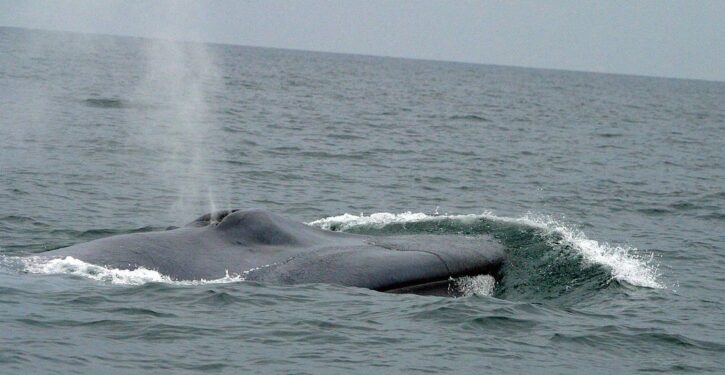
Blue whales — the largest creatures on Earth — are making a comeback in the Antarctic, a generation after whaling diminished due to the collapse of the Soviet Union.
Australian scientists spent two decades listening for their distinctive songs and calls, and have found the whales swimming across the Southern Ocean with growing regularity, reports The Guardian: “The whales were heard increasingly often in the Southern Ocean from 2006 to 2021, according to a new paper collating the findings of Australian and international researchers’ seven voyages across the period. The Antarctic blue whale nearly became extinct before whaling’s decline in the mid-20th century, with the most latest estimates from 1998 suggesting there were fewer than 2,000 alive. Researchers have spent hours listening for repeating songs about 20 seconds long, termed Z calls, along with shorter, higher-pitched D calls, in an effort to track and study the critically endangered species….The scientists travelled nearly 150,000km across the Southern Ocean tracking the whales’ appearances around Antarctica.”
The Antarctic is not the only place where whale populations are recovering. “Blue whales – the largest animals on Earth – are making their home in a part of the Indian Ocean where they were wiped out by whaling decades ago,” reported the BBC last year.
They were wiped out because the communist Soviet Union set arbitrary whale-harvesting targets, resulting in whaling ships killing whales even when they could not be used for any practical purpose, leaving most of the whale “to rot” in the sea.
But now, blue whales are thriving in the Seychelles islands. “Researchers, including scientists from the University of Seychelles, described the discovery as a ‘conservation win’ after the Soviet whaling fleet decimated the population in the 1960s,” the BBC says. “It turns out if you stop killing animals on mass scales and you give them a chance to rebound, they can recover,” says Dr. Stafford.
In a single year during the 1930s, whalers killed 30,000 blue whales. Under socialism, Russia slaughtered much of the world’s whales, at least 180,000 of them. It killed far more indiscriminately than other whaling nations, and unlike them, it largely wasted the whales it killed, leaving their carcasses to rot.
It has been called the most senseless environmental crime of the 20th Century. The Russians destroyed whole humpback whale populations — secretly, in violation of a treaty that Russia’s socialist government had signed during the Soviet Union:
It was one of the fastest decimations of an animal population in world history—and it had happened almost entirely in secret. The Soviet Union was a party to…a 1946 treaty that limited countries to a set quota of whales each year. By…1986, the Soviets had reported killing a total of 2,710 humpback whales in the Southern Hemisphere. In fact, the country’s fleets had killed nearly 18 times that many, along with thousands of unreported whales of other species. It had been an elaborate and audacious deception: Soviet captains had disguised ships, tampered with scientific data, and misled international authorities for decades.
All this killing was economically a waste. It was killing for killing’s sake:
Unlike Norway and Japan, the other major whaling nations of the era, the Soviet Union had little real demand for whale products. Once the blubber was cut away for conversion into oil, the rest of the animal, as often as not, was left in the sea to rot or was thrown into a furnace and reduced to bone meal—a low-value material used for agricultural fertilizer
Why did Russia kill so many whales and then waste their flesh? Central planning required whalers to kill the numbers of whales set by bureaucrats, regardless of whether Russia actually had any use for most parts of the whales killed:
Whaling, like every other industry in the Soviet Union, was governed by the dictates of the State Planning Committee of the Council of Ministers, a government organ tasked with meting out production targets. In the grand calculus of the country’s planned economy, whaling was considered a satellite of the fishing industry. This meant that the progress of the whaling fleets was measured by the same metric as the fishing fleets: gross product, principally the sheer mass of whales killed.
Whaling fleets that met or exceeded targets were rewarded handsomely, their triumphs celebrated in the Soviet press and the crews given large bonuses. But failure to meet targets came with harsh consequences. Captains would be demoted and crew members fired.
These production targets had nothing to do with whether whale meat actually was of any use to Russia’s consumers or industries, as Alfred Berzin, a Soviet-era fisheries scientist, explained:
The Soviet whalers, Berzin wrote, had been sent forth to kill whales for little reason other than to say they had killed them. They were motivated by an obligation to satisfy obscure line items in the five-year plans that drove the Soviet economy, which had been set with little regard for the Soviet Union’s actual demand for whale products. “Whalers knew that no matter what, the plan must be met!” Berzin wrote….Looking for whales they would go farther and farther from the islands and bring rotten baleen whales to the stations, those which could not be used for food. This was not regarded as a problem by anybody. The plan—at any price! And whalers were killing everything.
Government ownership of other industries, like agriculture, also has had negative effects on the environment. A classic example is in Soviet Central Asia, where the vast Aral Sea largely disappeared, leaving behind a vast ecologically-ruined wasteland, after a massive cotton project by the socialist government ravaged the regional environment. As the London Daily Mail noted, “The shrunken sea has ruined the once-robust fishing economy and left fishing trawlers stranded in sandy wastelands, leaning over as if they dropped from the air. The sea’s evaporation has left layers of highly salted sand, which winds can carry as far away as Scandinavia and Japan, and which plague local people with health troubles.”



